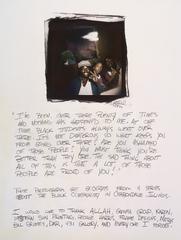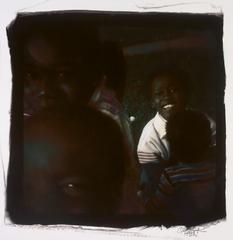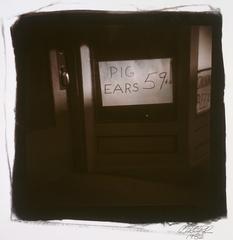|
The writing
on the photograph:
“I’ve
been over there plenty of times and nothing has happened to me.
At one time black students always went over there. It’s not
dangerous so what keeps you from going over there? Are you ashamed
of those people? You must think you’re better than they are.
The sad thing about all of this is that alot of those people are
proud of you!”
These photographs
are excerpts from a series about the black community in Carbondale,
Illinois.
I would like
to thank ALLAH, Gamma Group, Karen, Western Sun printing, George
Harris, Frame Designs, Matrix, Bill Grimes, Dar, 431 Gallery, and
everyone I forgot.
|
Photographer Carl Pope intended
this picture to introduce his series of photographs documenting the black
community of Carbondale, Illinois. Carbondale is near Southern Illinois
University, where Pope was a student. The photograph and accompanying
text, Pope explains, “indirectly speaks about the history of the
people in the black community in Carbondale. The history of this area
in Carbondale is that they embraced the black students who came there.
They were proud of the black students who came there, even though it was
a poor community. On the weekends the black students would spend a lot
of time in that neighborhood getting their hair cut, partying in the clubs
on Friday and Saturday nights.”“But because of drugs and upward
mobility and possibly integration, the black students quit going over
there and there began to be an animosity and sort of a hierarchy between
the black students and the townspeople. There began to be rhetoric about
that neighborhood ‘across the tracks,’ about the townspeople:
‘you shouldn’t go over there, its dangerous.’ It was probably
true,” says Pope. “Because of the growing split between the
haves and the have-nots and drugs and alcoholism and hopelessness, there
was probably anger and resentment. It wasn’t always that way but
it had started when I got there.”
The writing on the photograph is a quote from a conversation Pope had
about how it is not dangerous in the Carbondale neighborhood, but the
kids in the photo are showing gang signs. Does Pope think that the picture
contradicts the text?
“I never had any problem,” laughs Pope. “It is just like
my friends who go to Egypt. Right now they say on the news that Egypt
can be dangerous for white Americans. If you are black in Egypt they think
you are African. So the question is: dangerous for who?”
|

















